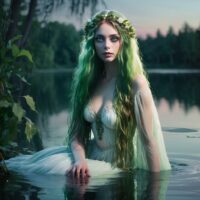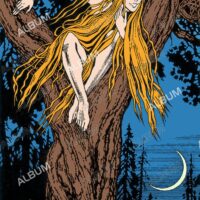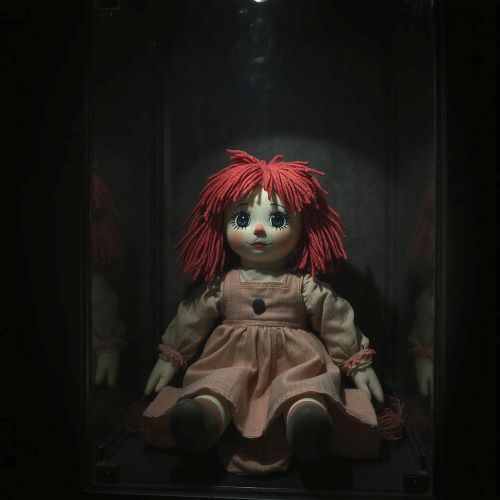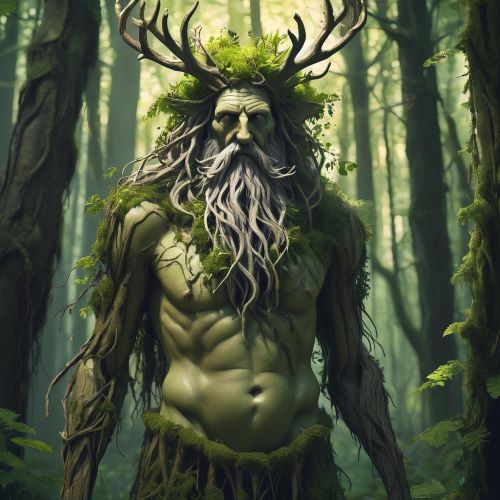Rusalka : The Water Spirit
Listen
At a glance
| Description | |
|---|---|
| Origin | Slavic Mythology |
| Classification | Spirits |
| Family Members | N/A |
| Region | Russia, Ukraine, Belarus, and Poland |
| Associated With | Rivers and lakes, Summon storms, and Cause flooding |
Rusalka
Introduction
The Rusalka is a mysterious female spirit in Slavic folklore, closely tied to bodies of water and often depicted as dangerous to humans. The word “rusalka” comes from “rusalija,” which traces its roots to the Latin “Rosālia,” a term linked to Pentecost. Ancient traditions likely predate Christianity, connecting this time of year with spirits later named after the holiday. Rusalki frequently appear in Slavic popular culture, often resembling mermaids. While their stories vary by region, they consistently embody both allure and peril, making them enduring figures in Eastern European mythology.
Physical Traits
Rusalki are often portrayed as enchanting, ethereal maidens with long, flowing hair, which can be blonde, black, or even green, reflecting their deep connection to water. Their pale skin and mesmerizing eyes further enhance their otherworldly beauty. Traditionally, their loose hair symbolizes their unmarried status, a detail tied to Slavic customs where unmarried women wore their hair unbraided. In some versions of their lore, Rusalki have disproportionately long arms, while in others, they are depicted as pale little girls or even with a more monstrous appearance, such as being hairy and deformed.
In different regions, Rusalki take on various forms. In Poland and the Czech Republic, water Rusalki are young and fair-haired, while forest Rusalki are often portrayed as more mature with black hair, which turns green, and their faces become distorted upon closer look. A key symbol of the water maiden is the comb, usually crafted from fish bones. Though Rusalki are typically bound to water, some stories allow them to leave their aquatic realm, where they are seen singing, dancing, or simply sitting by the water. They are also known to seduce men, and their appearance may even change to reflect the victim’s desires or represent an idealized form of beauty. Unlike mermaids, Rusalki have human-like legs. Despite their seductive allure, Rusalki’s beauty often hides a darker, more sinister side, drawing victims into their grasp.
Family
The origins of Rusalki vary across Slavic mythology, often rooted in sorrowful or supernatural events. In many traditions, they are believed to be the spirits of women who suffered tragic deaths, particularly by drowning. These could be young brides abandoned before their wedding, victims of betrayal, or women who took their own lives in despair. Bound to the water where they perished, they become restless spirits, luring the living into their fate.
In some legends, Rusalki are linked to ancient Slavic deities like the Bereginy, powerful nature spirits associated with forests, fertility, and protection. Other stories suggest that the first Rusalka was Kostroma, a maiden who unknowingly married her brother, Kupalo, and drowned herself in grief upon discovering the truth. In folklore and art, Rusalki are typically portrayed as living apart from men, existing in a world of their own. This theme is echoed in Antonín Dvořák’s opera Rusalka, where the protagonist’s father, the Water Spirit, serves as her guide and warns against the dangers of seeking human love, foreshadowing the tragic consequences of her choices.
Other names
Rusalki are known by different names across Slavic cultures, reflecting regional variations in folklore. In northern Russia, they have been called vodyanitsa, kupalka, shutovka, and loskotukha, while in Ukraine, they are often referred to as mavka. The term rusalka itself became more widely used in the 20th century, replacing older, more localized names. Other variations include moriana and wodiana, the latter evolving into topielica in some traditions.
In Czech and Slovak folklore, similar spirits are called vila, while the Polish equivalent is wiła. Though some of these names also apply to nature spirits tied to forests and mountains, they share many traits with Rusalki, reinforcing their role as supernatural beings connected to water and the untamed forces of nature. Despite regional differences, these spirits are often seen as variations of the same mythological archetype, embodying both beauty and danger.
Powers and Abilities
Originally, Rusalki were seen as benevolent spirits tied to fertility and agriculture, believed to bring moisture to the fields in spring to ensure a bountiful harvest. Over time, their image shifted to that of restless and dangerous entities, often linked to unclean spirits. They were said to emerge from the water during Rusalka Week in early June, swinging from willow and birch branches, their presence a warning to those who might cross their path.
Their supernatural abilities are both alluring and terrifying. Rusalki can manipulate water, summoning storms, floods, and hail to punish those who anger them. They are also known for their shapeshifting abilities, transforming into animals like frogs, birds, and even horses to deceive and evade. Their mesmerizing songs and beauty can ensnare victims, leading them into the depths where they meet their end—sometimes tangled in the Rusalka’s long hair or even tickled to death.
Despite their fearsome reputation, not all Rusalki are malevolent. Some folklore depicts them as protectors of nature, guiding travelers, aiding fishermen, or even using enchanted water to heal the sick. These gentler Rusalki reward those who respect their domain, reinforcing the belief that the spirits of water must be honored rather than feared.
Modern Day Influence
The Rusalka has undergone significant transformations in modern popular culture, shifting from a mystical nature spirit to a more humanized and often seductive figure. Literature has played a key role in shaping this evolution, with works like Alexander Pushkin’s Rusalka and Antonín Dvořák’s opera of the same name exploring themes of love, betrayal, and the supernatural. Writers such as Orest Somov, Mikhail Lermontov, and C.J. Cherryh have also drawn inspiration from the legend, weaving it into their narratives.
Beyond literature, Rusalki appear across various media, from video games like The Witcher and Heroes of Might and Magic to modern fantasy novels like Katherine Arden’s The Bear and the Nightingale and Christopher Buehlman’s The Necromancer’s House. These adaptations often blend traditional Slavic folklore with contemporary storytelling, reinterpreting the Rusalka as a mysterious yet compelling figure.
In visual arts, Rusalki continue to inspire artists who depict them as ethereal, melancholic beings caught between worlds. Their haunting presence serves as a symbol of nature’s untamed beauty and hidden dangers, ensuring that their legend endures in both traditional and modern creative expressions.
Related Images
Source
Ivanits, Linda J. Russian Folk Belief. M.E. Sharpe, 1989.
Ralston, William Ralston Shedden. Russian Folk-Tales. Gibbings and Company, 1916.
Warner, Elizabeth. Russian Myths. University of Texas Press, 2002.
“Rusalka.” Encyclopaedia Britannica. Accessed February 22, 2025.
“Rusalka.” . Accessed February 22, 2025.
“Rusalka.” Mythical Creatures Guide. Accessed February 22, 2025.
Frequently Asked Questions
What is lorem Ipsum?
I am text block. Click edit button to change this text. Lorem ipsum dolor sit amet, consectetur adipiscing elit. Ut elit tellus, luctus nec ullamcorper mattis, pulvinar dapibus leo.
What is lorem Ipsum?
I am text block. Click edit button to change this text. Lorem ipsum dolor sit amet, consectetur adipiscing elit. Ut elit tellus, luctus nec ullamcorper mattis, pulvinar dapibus leo.
What is lorem Ipsum?
I am text block. Click edit button to change this text. Lorem ipsum dolor sit amet, consectetur adipiscing elit. Ut elit tellus, luctus nec ullamcorper mattis, pulvinar dapibus leo.
What is lorem Ipsum?
I am text block. Click edit button to change this text. Lorem ipsum dolor sit amet, consectetur adipiscing elit. Ut elit tellus, luctus nec ullamcorper mattis, pulvinar dapibus leo.
What is lorem Ipsum?
I am text block. Click edit button to change this text. Lorem ipsum dolor sit amet, consectetur adipiscing elit. Ut elit tellus, luctus nec ullamcorper mattis, pulvinar dapibus leo.







